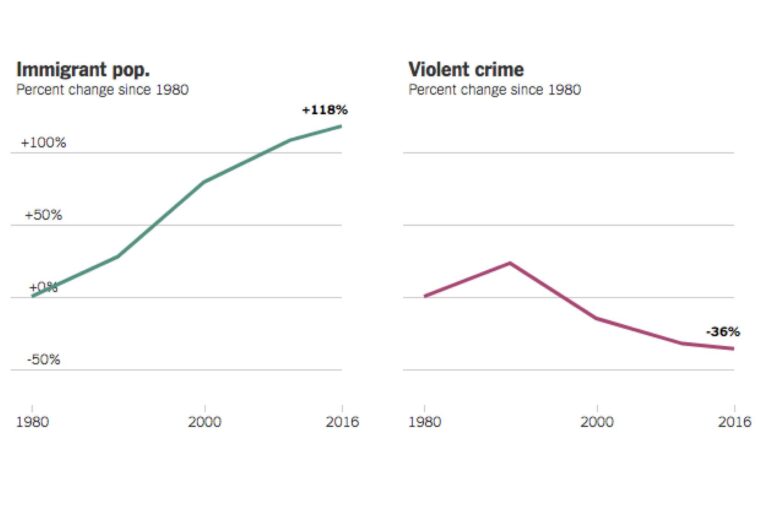A recent report from Voxeurop challenges common perceptions by asserting that there is no direct causal link between immigration and crime. Drawing on data and expert analysis, the article addresses widespread public concern and policy debates surrounding immigration’s impact on safety and crime rates. This finding calls into question narratives that often associate migrant populations with increased criminal activity, emphasizing the need for more nuanced discussions grounded in evidence rather than assumption.
Examining the Evidence Behind Immigration and Crime Rates
Extensive research analyzing crime statistics across multiple countries consistently finds that immigration does not inherently increase crime rates. In fact, data often shows immigrants commit crimes at lower rates than native-born populations, once socio-economic factors are controlled for. Several studies highlight how focusing on immigration status alone oversimplifies complex social dynamics and risks fostering harmful stereotypes. Key factors such as poverty, education, and community integration play a more significant role in influencing crime than immigration status itself.
Key findings across studies include:
- Immigrant populations frequently have lower rates of violent and property crime compared to native-born citizens.
- Second-generation immigrants tend to have crime rates closer to the general population, reflecting socio-economic integration rather than ethnicity.
- Areas with high immigrant concentrations often experience lower rates of crime and increased community cohesion.
| Country | Immigrant Crime Rate (%) | Native Crime Rate (%) |
|---|---|---|
| Germany | 3.4 | 4.1 |
| France | 2.8 | 3.5 |
| Sweden | 5.0 | 5.6 |
Overall, the evidence stresses the importance of addressing underlying social inequalities rather than attributing crime trends directly to immigration. This nuanced understanding calls for policy approaches focused on integration, education, and economic opportunity to reduce crime effectively and foster social cohesion.
Understanding the Social and Economic Factors Influencing Crime
Crime rates are commonly analyzed through the lens of various social and economic factors that significantly influence individual and community behavior. Poverty, education levels, and employment status remain some of the most critical determinants impacting crime. Areas plagued by unemployment and limited access to quality education often experience higher crime rates, not because of the demographic composition but due to systemic inequalities and lack of opportunities. Furthermore, social disorganization in neighborhoods—characterized by weakened social institutions and low community cohesion—can erode informal social controls, leading to increased criminal activity.
To better illustrate these influences, consider the following table summarizing key factors and their correlations with crime rates:
| Factor | Impact on Crime | Mechanism |
|---|---|---|
| Poverty | High correlation | Economic strain driving survival crimes |
| Education | Inverse correlation | Higher education reduces recidivism |
| Employment | Moderate correlation | Job stability deters illicit activity |
| Community Cohesion | Negative correlation | Strong networks discourage crime |
These insights emphasize that crime is a social phenomenon deeply embedded in structural conditions rather than the simplistic attribution to immigration status. Recognizing the complex interplay of socioeconomic factors helps shift the narrative from stigma to informed policy-making geared toward addressing root causes and fostering safer communities.
Policy Recommendations for Addressing Public Concerns on Immigration
To effectively address public concerns regarding immigration and perceived associations with crime, policymakers must prioritize evidence-based strategies that foster social cohesion rather than fueling misconceptions. Transparent communication campaigns highlighting the lack of direct causal links between immigration and crime can counteract misinformation and reduce societal fear. Investing in community engagement programs that encourage intercultural dialogue and mutual understanding is essential for building trust between immigrants and local residents.
Additionally, tailored policy interventions should focus on improving integration outcomes, which indirectly contribute to public safety. Key recommendations include:
- Enhancing access to education and vocational training for immigrants to reduce economic disparities.
- Implementing localized support services that address social exclusion and promote inclusion.
- Strengthening law enforcement practices through cultural competency training to avoid bias and ensure equal protection under the law.
| Policy Area | Expected Impact |
|---|---|
| Education and Training | Lower unemployment, greater social mobility |
| Community Engagement | Increased social trust, reduced prejudice |
| Law Enforcement Reform | Fair policing, community cooperation |
The Role of Media in Shaping Perceptions of Immigration and Safety
Media outlets play a pivotal role in molding public opinion on immigration and crime, often shaping societal perceptions beyond the reality of statistical evidence. Sensational headlines and selective reporting can contribute to a climate of fear and misconception, linking immigration implicitly or explicitly to criminal activity. This often overshadows comprehensive research showing that immigration does not inherently increase crime rates. In many cases, media narratives focus on isolated incidents, inflating their significance while neglecting broader data trends that highlight no direct causal relationship.
Various factors influence how the public receives information about immigrants and safety, including:
- Frequency of crime-related immigration stories: Repetitive coverage of specific cases can create a false perception of widespread issues.
- Choice of language and imagery: Words with negative connotations and emotive images can bias audience reactions subconsciously.
- Lack of context: Omitting data on socioeconomic factors or official statistics presents an incomplete picture.
| Media Influence Aspect | Potential Impact |
|---|---|
| Sensational Headlines | Amplifies fear, distorts reality |
| Selective Reporting | Creates biased narratives |
| Context Omission | Misleads public understanding |
Key Takeaways
In conclusion, the evidence presented by Voxeurop challenges common misconceptions about the relationship between immigration and crime. By highlighting the absence of a direct causal link, the article calls for a more nuanced and evidence-based public discourse. As migration continues to shape societies across Europe, understanding the complex factors behind crime rates remains essential for informed policy-making and fostering social cohesion.




